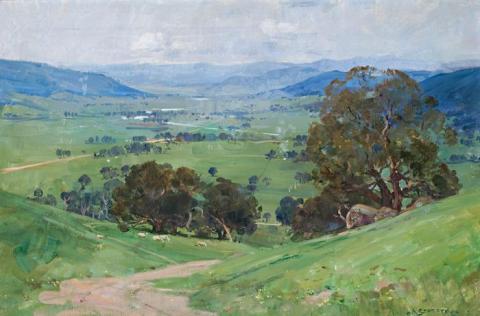GREEN VALLEY, c.1929-30
Arthur Streeton
oil on canvas
51.0 x 76.5 cm
signed lower right: A STREETON
inscribed with title verso
Fine Art Society's Gallery, Melbourne
Private collection, Melbourne
Earl Gallery, Geelong
Sotheby's, Melbourne, 28 April 1998, lot 58
Private collection, Sydney
Exhibition of Oil Paintings by Arthur Streeton, Fine Art Society's Gallery, Melbourne, 17 – 28 March 1931, cat. 7
Streeton, A., The Arthur Streeton Catalogue, Melbourne, 1935, cat. 1017
When Arthur Streeton painted Green Valley, c.1929-30, he was at the height of his fame. Will Ashton had written 'I know of no other artist who is painting better landscapes than those by Streeton.'1 In January 1929 Streeton was awarded the 1928 Wynne Prize for his painting Afternoon Light, Goulburn Valley, Victoria, 1927, (National Gallery of Australia, Canberra); and the same year he was appointed art critic for the Melbourne Argus newspaper. Extraordinary as it may seem, the Wynne Prize was the first Streeton won in an art competition.2 The spotlight on his art beamed ever brighter when, in 1931, the Art Gallery of New South Wales honoured him with a special loan exhibition of his works, and Art in Australia gave its seal of approval with the 'Arthur Streeton Number' published in October of the same year. His solo exhibitions were both numerous and successful. Green Valley was one of twenty-three landscapes and flower paintings shown in his Melbourne exhibition of April 1931. Harold Herbert gave it an enthusiastic review in The Argus. 'His unfailing sureness is a source of wonder. His unerring vision and sense of colour and atmosphere in Australian landscape are unique.'3 Describing Streeton as 'a master of his medium', Herbert continued, 'The great thing is the lasting impression of a landscape filled with light, a valley panorama such as we know and enjoy.'
Although now settled at Olinda in Melbourne's Dandenong Ranges, Streeton did not confine himself in his choice of landscapes. The 1931 exhibition included a diverse range - The Murray and the Mountain, Towong Gap, Kosciusko and The Road to Corryong, as well as Approaching Storm, Olinda and Sassafras. His landscapes, however, moved between the Arcadian view and the relentless threat to the environment. In the monumental painting, The Vanishing Forest, 1934, Streeton warns of environmental disaster in its telling images of uprooted gum and stark white trunks of dead trees.
Green Valley evokes a more positive note of the Australian pastoral ideal, different from his golden pastures only in the green richness of the landscape. Handled with all the assurance that characterises his later paintings, its atmosphere is one of plenitude. The grazing sheep feed on the abundant grass, the river is full and flows glistening in the gentle light, and the blue hills provide a bulwark against alien intrusion.
1. Art in Australia, Sydney, March 1927, p. 11
2. Letter to Oscar Paul, 29 January 1929, quoted in Smith, G., Arthur Streeton 1867-1943, National Gallery of Victoria, Melbourne, 1995, p. 172
3. Herbert, H., 'Art of Arthur Streeton: Sunlit Landscapes: Beautiful Flower Pieces', Argus, Melbourne, 17 March 1931, p. 8
DAVID THOMAS
